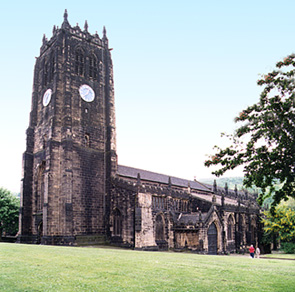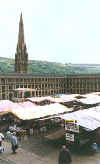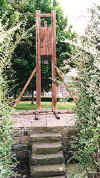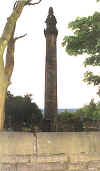![]()

HALIFAX
Motto: nisi Dominus custodierit civitatem
(except the Lord keep the city, the watchman waketh in vain)

Halifax Parish Church
If you search for Halifax on the internet you will be directed towards Halifax PLC, Halifax, Nova Scotia and Halifax County, North Carolina. But the town of Halifax in the West Riding of Yorkshire is the mother and father of them all.
Halifax stands on the rivers Calder and Hebble in the Pennines, south-west of Leeds and Bradford and virtually equidistant from both the Yorkshire and Lancashire coasts. Though it has existed since medieval times, like so many nearby towns and cities it owes its growth to the Industrial Revolution. In 1802 there were fewer than 9,000 inhabitants whilst today there are over 90,000. Nevertheless I have heard it described as the largest village in England; you can’t do much out of the ordinary without it being common knowledge in no time. The Halifax grapevine could still teach the internet a few things about speed of communication!
One grows up thinking that what one knows is the norm. As a child I took for granted what I now realise is very much a unique place - the stone buildings, the steep hills, the magnificent views, the bleakness of the nearby moors and the Victorian and Edwardian legacy.
Forty or fifty years ago Halifax was still an active industrial centre where the quality of life had been much improved by the legislation which outlawed the filthy air of earlier times. Textiles, carpets, machine tools, toffees and chocolates (Quality Street) were produced. Today much of that has gone save some specialised businesses which have been able to find niche markets. Halifax has had to reinvent itself and is not making so bad a job of the task. The biggest employer now is the Halifax PLC, formerly Halifax Building Society, the biggest in the world. What began in 1853 as a mutual society created to help house buyers is now a bank with town centre headquarters opened in 1973 of a style typical of the architecture of the time. Don’t ask. The words incongruous and frightful come to mind. Betjeman would better describe it than I can.
In fact architecturally Halifax has so much to offer despite the civic vandalism of the ‘60s and ‘70s. The Town Hall was designed by Barry who also designed the Houses of Parliament at Westminster. The Borough Market is a triumph of stone and ironwork. The Parish Church of Saint John the Baptist dates from the fifteenth century and reflects Halifax’s pre-industrial past. The hospitals, civic buildings, banks and even factories and workshops show what giants the Victorian fathers of these northern industrial towns were.
Piece Hall
click
But perhaps the greatest jewel is the Piece Hall, the only surviving cloth hall in Yorkshire and covering 10,000 square yards. This, opened in 1779, was the market for local handloom weavers and merchants who brought their ‘pieces’ of cloth for sale here. Around a central quadrangle are galleries with Tuscan and Rustic columns accommodating over 300 lock-up rooms. After the Industrial Revolution had left the Piece Hall stranded like a beached whale, it was allowed to deteriorate physically and in the 1970s was on the verge of being pulled down. One vote saved it! Can you believe what philistines the civic authorities were in those days? Now the Piece Hall has new life as a museum and gallery with shops selling antiques and collectables and the central area is used for concerts. Again it is appreciated for its distinctive beauty and at the same time it has a purpose. It is, of course, now a listed building. It was so nearly a pile of rubble.
Halifax Gibbet
Between the 13th and 17th centuries Halifax had a Gibbet, a guillotine used to execute those who stole animals or cloth drying on tenters (hanging, of course, on tenterhooks). It must have had a deterrent effect: ‘From Hull, Hell and Halifax, Good Lord deliver us’ became a famous saying in the criminal fraternity. A replica of the old gibbet was made in 1974 (Gibbet Street) and is a gruesome attraction; the original gibbet blade survives and is in the Calderdale Industrial Museum.
Wainhouse Tower
At King Cross, a mile outside Halifax, is Wainhouse Tower, a 280 foot high chimney encased in stone and surmounted by an elaborate viewing platform at the top of 400 steps. This was built between 1871 and 1875 by John Wainhouse seemingly as a result of a feud and with the purpose of intimidating his neighbour. Fear of accidents, or more to the point, litigation, which in so many ways is taking so much fun out of life, means that it is now very difficult to obtain access to the tower. The Council owns it so, as you can imagine, it is not treated with respect.
One of my favourite places is Heptonstall which is above Hebden Bridge (itself wonderful) a few miles west of Halifax. Heptonstall is on the old pack horse road to Colne where the moors are bleaker than nearby Haworth where the Brontės lived. Here is the ruined, 13th century parish church destroyed in a storm in 1847 and the new church which replaced it. There is also an unusual octagonal Methodist Church designed by John Wesley. In Heptonstall are the graves of David Hartley, the Cragg Vale coiner (another story), and Sylvia Plath, the American poet. But the main interest of the area is its geography, the village on the top of a wild and windswept hill with breathtaking views across the hills and valleys. The twentieth century is a million miles away and one looks at the sky and wonders.
When I went to university I regarded Halifax as provincial, old-fashioned, a quiet backwater with small town views. I still do but the difference is that now these are terms of endearment, part of the charm and attraction of the place.
David Brearley



